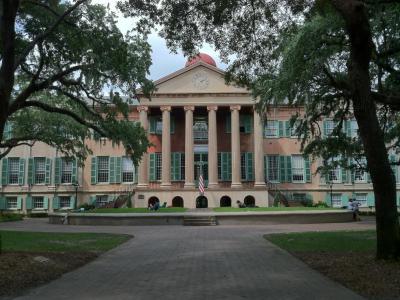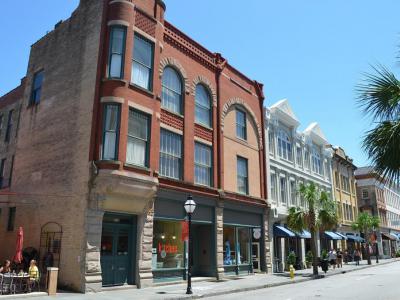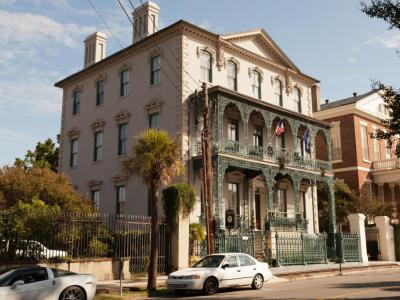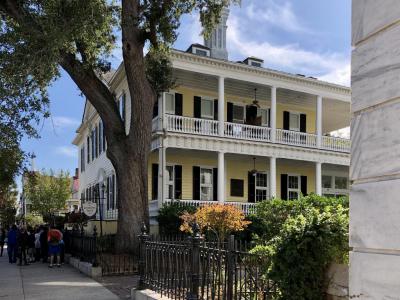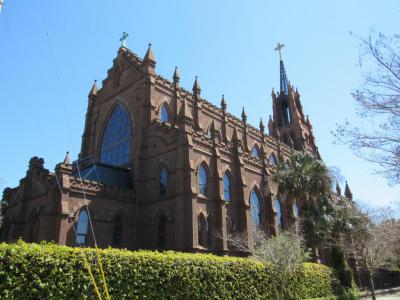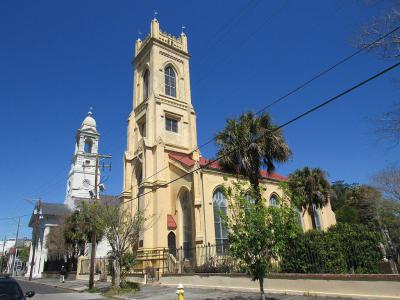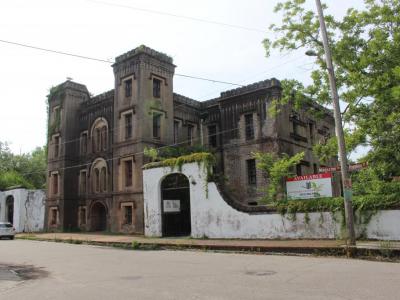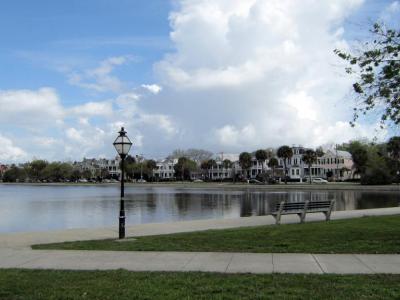Harleston Village Walking Tour (Self Guided), Charleston
Founded in the 18th century, the historic Harleston Village is a charming neighborhood in Charleston, South Carolina. The rich past and vibrant present of this area make it a popular destination for tourists.
At the heart of Harleston Village lies the College of Charleston, an esteemed institution of higher learning, established in 1770, adding a great deal of academic flair to the neighborhood.
Another prominent sight of Harleston is King Street, one of its main arteries. A hub for shopping and dining, this bustling thoroughfare is lined with an array of shops, boutiques, and restaurants, offering everything – from trendy fashion to culinary delights.
Harleston Village also boasts several historic landmarks, such as the John Rutledge House Inn and the Edward Rutledge House, also known as the Governor's House Inn. These elegant buildings are the former dwellings of two signers of the Declaration of Independence.
The neighborhood abounds in religious significance as well, with the majestic Cathedral of Saint John the Baptist and the picturesque Unitarian Church in Charleston gracing its streets.
For history enthusiasts, the Old Charleston Jail and the Old Marine Hospital offer fascinating insights into Charleston's past, showcasing its heritage as a thriving port city.
Colonial Lake, a serene and picturesque park, provides a peaceful escape in the heart of Harleston Village. It's an ideal spot for a leisurely stroll, a family picnic, or simply to enjoy the natural beauty of the area.
The captivating Harleston Village of Charleston brims with history, culture, and vibrant energy. You will surely find something to pique your interest here, no doubt. So, whenever you're in Charleston, plan a visit to Harleston and experience the hospitality this part of the town is known for!
At the heart of Harleston Village lies the College of Charleston, an esteemed institution of higher learning, established in 1770, adding a great deal of academic flair to the neighborhood.
Another prominent sight of Harleston is King Street, one of its main arteries. A hub for shopping and dining, this bustling thoroughfare is lined with an array of shops, boutiques, and restaurants, offering everything – from trendy fashion to culinary delights.
Harleston Village also boasts several historic landmarks, such as the John Rutledge House Inn and the Edward Rutledge House, also known as the Governor's House Inn. These elegant buildings are the former dwellings of two signers of the Declaration of Independence.
The neighborhood abounds in religious significance as well, with the majestic Cathedral of Saint John the Baptist and the picturesque Unitarian Church in Charleston gracing its streets.
For history enthusiasts, the Old Charleston Jail and the Old Marine Hospital offer fascinating insights into Charleston's past, showcasing its heritage as a thriving port city.
Colonial Lake, a serene and picturesque park, provides a peaceful escape in the heart of Harleston Village. It's an ideal spot for a leisurely stroll, a family picnic, or simply to enjoy the natural beauty of the area.
The captivating Harleston Village of Charleston brims with history, culture, and vibrant energy. You will surely find something to pique your interest here, no doubt. So, whenever you're in Charleston, plan a visit to Harleston and experience the hospitality this part of the town is known for!
How it works: Download the app "GPSmyCity: Walks in 1K+ Cities" from Apple App Store or Google Play Store to your mobile phone or tablet. The app turns your mobile device into a personal tour guide and its built-in GPS navigation functions guide you from one tour stop to next. The app works offline, so no data plan is needed when traveling abroad.
Harleston Village Walking Tour Map
Guide Name: Harleston Village Walking Tour
Guide Location: USA » Charleston (See other walking tours in Charleston)
Guide Type: Self-guided Walking Tour (Sightseeing)
# of Attractions: 9
Tour Duration: 2 Hour(s)
Travel Distance: 2.3 Km or 1.4 Miles
Author: alice
Sight(s) Featured in This Guide:
Guide Location: USA » Charleston (See other walking tours in Charleston)
Guide Type: Self-guided Walking Tour (Sightseeing)
# of Attractions: 9
Tour Duration: 2 Hour(s)
Travel Distance: 2.3 Km or 1.4 Miles
Author: alice
Sight(s) Featured in This Guide:
- College of Charleston
- King Street
- John Rutledge House Inn
- Edward Rutledge House (Governor's House Inn)
- Cathedral of St. John the Baptist
- Unitarian Church in Charleston
- Old Charleston Jail
- Old Marine Hospital
- Colonial Lake
1) College of Charleston
The College of Charleston, the oldest college in South Carolina and the nation's first municipal college, is not only a custodian of the city's history but also injects a modern and youthful energy with its diverse student body of over 12,000. While the campus features contemporary buildings, a leisurely walk around its picturesque grounds unveils some historical treasures.
One such gem is the Bishop Robert Smith House, dating back to the college's founding year of 1770, which now serves as the president's residence. (You can find it on Glebe Street, between Wentworth and George streets). Dominating the surroundings is the stately Greek revival portico of Randolph Hall, an 1828 structure designed by Philadelphia architect William Strickland and constructed with the labor of enslaved individuals. This iconic building overlooks the college's central Cistern Yard, where lush oak trees provide a picturesque backdrop for events such as graduation ceremonies and concerts, including performances during the Spoleto Festival USA. The campus has also been a backdrop for scenes in movies like 'Cold Mountain' and 'The Notebook'.
Tip:
For those looking to enhance their visit, an iPhone app called "College of Charleston Tour" is available for a self-guided tour, complete with videos (free on the App Store). Additionally, if you're interested in exploring traveling exhibitions featuring artists from around the world, make sure to visit the Halsey Institute of Contemporary Art, which adds a unique dimension to Charleston's museum offerings.
One such gem is the Bishop Robert Smith House, dating back to the college's founding year of 1770, which now serves as the president's residence. (You can find it on Glebe Street, between Wentworth and George streets). Dominating the surroundings is the stately Greek revival portico of Randolph Hall, an 1828 structure designed by Philadelphia architect William Strickland and constructed with the labor of enslaved individuals. This iconic building overlooks the college's central Cistern Yard, where lush oak trees provide a picturesque backdrop for events such as graduation ceremonies and concerts, including performances during the Spoleto Festival USA. The campus has also been a backdrop for scenes in movies like 'Cold Mountain' and 'The Notebook'.
Tip:
For those looking to enhance their visit, an iPhone app called "College of Charleston Tour" is available for a self-guided tour, complete with videos (free on the App Store). Additionally, if you're interested in exploring traveling exhibitions featuring artists from around the world, make sure to visit the Halsey Institute of Contemporary Art, which adds a unique dimension to Charleston's museum offerings.
2) King Street
King Street and its surroundings are, perhaps, the most happening areas in Charleston. It is also the second most historically and architecturally significant downtown lane, (after Meeting Street), where the city's past and present converge. With a history spanning more than three centuries, this thoroughfare was named for King Charles II of England and soon thrived as a retail corridor, commercial center, and a major shopping district, hosting a diverse array of high-end specialty shops.
Do you like it upscale? Even if not for shopping, a leisurely stroll down this street's pedestrian-friendly sidewalks impresses with stores offering unique and handmade jewelry, antiques, gifts, shoes, and fine clothing; as well as galleries showcasing the work of local artists and artisans. Peculiar enough, many local stores still "dress" their windows as they did back in the old days. There's also no shortage of trendy restaurants and cool little coffee and dessert shops here either, worth stopping by and taking a break.
With such an abundance of options, you may find yourself wondering where to begin your exploration. As you plan your visit, it's worth noting that King Street can be divided into three sections: the lower section, known for its top-notch antiques and jewelry boutiques; the middle section, home to upscale brand-name stores and some exceptional shoe shops; and the upper section, characterized by more cutting-edge boutiques and housewares stores (often locally owned and with a personal touch), along with a vibrant restaurant scene. Feel free to explore at your own pace and delight in the offerings of each section.
Tip:
Keep an eye out for "Second Sundays on King," an event where the street is closed to cars throughout the afternoon, spanning from Calhoun Street to Queen Street. Plus, don't miss the Saturday farmers' market in Marion Square during the spring and summer months.
Do you like it upscale? Even if not for shopping, a leisurely stroll down this street's pedestrian-friendly sidewalks impresses with stores offering unique and handmade jewelry, antiques, gifts, shoes, and fine clothing; as well as galleries showcasing the work of local artists and artisans. Peculiar enough, many local stores still "dress" their windows as they did back in the old days. There's also no shortage of trendy restaurants and cool little coffee and dessert shops here either, worth stopping by and taking a break.
With such an abundance of options, you may find yourself wondering where to begin your exploration. As you plan your visit, it's worth noting that King Street can be divided into three sections: the lower section, known for its top-notch antiques and jewelry boutiques; the middle section, home to upscale brand-name stores and some exceptional shoe shops; and the upper section, characterized by more cutting-edge boutiques and housewares stores (often locally owned and with a personal touch), along with a vibrant restaurant scene. Feel free to explore at your own pace and delight in the offerings of each section.
Tip:
Keep an eye out for "Second Sundays on King," an event where the street is closed to cars throughout the afternoon, spanning from Calhoun Street to Queen Street. Plus, don't miss the Saturday farmers' market in Marion Square during the spring and summer months.
3) John Rutledge House Inn
Sitting on the north side of Broad Street in the historic center of Charleston, the John Rutledge House Inn is close to the old South of Broad neighborhood not only in terms of location but also in terms of feel. Renowned as "America's most historic inn", this house boasts a fine old pedigree. Constructed in the 1760s for the Constitution signer John Rutledge, it is one of just fifteen residences belonging to the original signatories that have endured the test of time. Even George Washington himself enjoyed breakfast within its walls, joining a long list of patriots, statesmen, and presidents who came to visit Mr. Rutledge.
Today, the towering three-story structure stands as one of Charleston's most sought-after bed-and-breakfasts, holding a prestigious AAA Four-Diamond rating. While the building has been modernized to incorporate all modern conveniences and is furnished with elegant yet exceptionally comfortable furniture, history still permeates every nook and cranny here. Overall, there are 19 guest rooms, ranging in size from standard to spacious, inside the main house and two carriage houses at the rear of the property. The interior is a showcase of period splendor, featuring Italian marble fireplaces, original plaster moldings, and exquisite ironwork in the public areas. The ballroom, open to the public, serves as a delightful venue for afternoon tea and breakfast.
Today, the towering three-story structure stands as one of Charleston's most sought-after bed-and-breakfasts, holding a prestigious AAA Four-Diamond rating. While the building has been modernized to incorporate all modern conveniences and is furnished with elegant yet exceptionally comfortable furniture, history still permeates every nook and cranny here. Overall, there are 19 guest rooms, ranging in size from standard to spacious, inside the main house and two carriage houses at the rear of the property. The interior is a showcase of period splendor, featuring Italian marble fireplaces, original plaster moldings, and exquisite ironwork in the public areas. The ballroom, open to the public, serves as a delightful venue for afternoon tea and breakfast.
4) Edward Rutledge House (Governor's House Inn)
Constructed in 1760 by John Laurens, this is Charleston's oldest house currently functioning as a bed-and-breakfast. It is the former residence of Edward Rutledge, the younger brother of John Rutledge and the youngest signer of the Declaration of Independence, who also served as the governor of South Carolina from 1798 to 1800. Trained in law in England, Rutledge established his legal practice in Charleston before becoming involved in the First and Second Continental Congresses. During the American Revolutionary War, he was taken prisoner after being captured during the 1780 Siege of Charleston.
Today, this property is a National Historic Landmark, featuring 11 beautifully decorated guest rooms. The Laurens room offers picturesque views of the historic architecture in the area, while the Jefferson Suite features a separate living room, private porch, wet bar, and an original 1760 fireplace. Guests can enjoy a Southern gourmet breakfast as well as afternoon tea and evening sherry. The location is ideal, situated on the periphery of the original Grand Modell city and the prestigious Below Broad residential area. Additionally, it's within convenient walking distance of King Street's shopping and antiques district.
Today, this property is a National Historic Landmark, featuring 11 beautifully decorated guest rooms. The Laurens room offers picturesque views of the historic architecture in the area, while the Jefferson Suite features a separate living room, private porch, wet bar, and an original 1760 fireplace. Guests can enjoy a Southern gourmet breakfast as well as afternoon tea and evening sherry. The location is ideal, situated on the periphery of the original Grand Modell city and the prestigious Below Broad residential area. Additionally, it's within convenient walking distance of King Street's shopping and antiques district.
5) Cathedral of St. John the Baptist
The first Cathedral of Saint John the Baptist, completed in 1854, stood as a remarkable specimen of Gothic architecture. Crafted from Connecticut sandstone and crowned by a 200-foot spire, it tragically succumbed to the devastating fire of 1861. However, by 1890, the reconstruction of an almost exact replica of the original edifice had commenced. The design, attributed to Patrick Kelly of Brooklyn, New York, closely adhered to the plans of its predecessor, except for the substitution of a square tower due to budgetary constraints.
It wasn't until 103 years later that a new spire, along with three bells, was finally added atop the tower, culminating the restoration of the historic structure. Comprising Connecticut brownstone, the newer building was eventually completed in 2010. The spacious nave, measuring 150 by 80 feet, is adorned with exquisite stained-glass windows and has a seating capacity for 700 individuals.
Why You Should Visit:
To admire one of North America's most splendid churches, with its unique stained-glass windows, altar, and architectural grandeur.
Tip:
Try to visit on a sunny day to fully appreciate the intricate patterns and colors of the stained-glass windows.
It wasn't until 103 years later that a new spire, along with three bells, was finally added atop the tower, culminating the restoration of the historic structure. Comprising Connecticut brownstone, the newer building was eventually completed in 2010. The spacious nave, measuring 150 by 80 feet, is adorned with exquisite stained-glass windows and has a seating capacity for 700 individuals.
Why You Should Visit:
To admire one of North America's most splendid churches, with its unique stained-glass windows, altar, and architectural grandeur.
Tip:
Try to visit on a sunny day to fully appreciate the intricate patterns and colors of the stained-glass windows.
6) Unitarian Church in Charleston
The initial construction on this site commenced just as the American Revolution was unfolding. During the British occupation of the city, the Georgian-style church served as lodging for the British militia and suffered damage, including the destruction of its newly installed pews; however, it was eventually repaired and returned to use by 1787. For the subsequent three decades, it operated as a unified entity with the Meeting Street Independent Church (now known as the Circular Church); nevertheless, in 1839, this congregation was reconstituted as the Unitarian Church.
Charleston experienced a period of considerable affluence in the 1850s, prompting the Unitarians to engage the services of the young architect Francis D. Lee, who was also a member of the church. His task was to remodel the structure in the increasingly popular Gothic Revival style, while preserving the existing walls and tower. Lee drew inspiration from the Henry VII chapel at Westminster Abbey, particularly the intricate and delicate fan tracery ceiling found there. He successfully replicated this remarkable ceiling in the church, rendering it one of the most exceptional examples of Gothic Revival architecture in the United States. The church premises also feature an intriguing garden and cemetery.
Why You Should Visit:
The sanctuary is lovely; the intentionally overgrown cemetery (free to visit when the gates are open) is a serene place to stroll or sit and reflect. The pathways are well-maintained, striking a balance between neatness and the wild beauty that draws you in.
Tip:
Consider swinging through the church when docents are available – they put on a pretty great tour and can offer further recommendations for exploring the town.
Charleston experienced a period of considerable affluence in the 1850s, prompting the Unitarians to engage the services of the young architect Francis D. Lee, who was also a member of the church. His task was to remodel the structure in the increasingly popular Gothic Revival style, while preserving the existing walls and tower. Lee drew inspiration from the Henry VII chapel at Westminster Abbey, particularly the intricate and delicate fan tracery ceiling found there. He successfully replicated this remarkable ceiling in the church, rendering it one of the most exceptional examples of Gothic Revival architecture in the United States. The church premises also feature an intriguing garden and cemetery.
Why You Should Visit:
The sanctuary is lovely; the intentionally overgrown cemetery (free to visit when the gates are open) is a serene place to stroll or sit and reflect. The pathways are well-maintained, striking a balance between neatness and the wild beauty that draws you in.
Tip:
Consider swinging through the church when docents are available – they put on a pretty great tour and can offer further recommendations for exploring the town.
7) Old Charleston Jail
The Old County Jail, in operation from 1802 to 1939, served as the confinement facility for some of Charleston's most notorious criminals, 19th-century pirates, and Civil War prisoners. Situated on Magazine Street in downtown Charleston, this historic building has recently undergone renovation, preserving the original design of the first floor while adding air conditioning for visitors' comfort. Guided tours are available for those interested in delving into the jail's intriguing history. During these tours, participants explore the cells, hallways, and areas where Charleston's earliest wrongdoers resided, gaining insight into the primitive forms of torture and harsh living conditions.
One of the captivating stories told during these tours is that of Lavinia Fisher, the jail's most famous inmate and the first female serial killer in the United States. Over the years, the jail has gained popularity as a tourist attraction, thanks in part to its appearances on various television shows such as Travel Channel, Food Network, Ghost Hunters, Ghost Adventures, and Ghost Brothers.
One of the captivating stories told during these tours is that of Lavinia Fisher, the jail's most famous inmate and the first female serial killer in the United States. Over the years, the jail has gained popularity as a tourist attraction, thanks in part to its appearances on various television shows such as Travel Channel, Food Network, Ghost Hunters, Ghost Adventures, and Ghost Brothers.
8) Old Marine Hospital
Designated as a National Historic Landmark, the Old Marine Hospital stands as a testament to the architectural prowess of Robert Mills, a Charleston native often hailed as the first professionally trained American architect. Known for his work on iconic structures like the Washington Monument and numerous public buildings across the nation, Mills also played a role in the development of a standardized design pattern for marine hospitals, using the one in Charleston as a model. Remarkably, out of approximately 30 marine hospitals constructed before the Civil War, only eight have survived to this day.
During its construction, the Old Marine Hospital became a focal point of controversy in Charleston's antebellum era. It was perceived by proponents of states' rights as a symbol of the Federal government's overreach, as funding for the hospital was deducted from sailors' wages and supplemented by taxes imposed on the shipping industry. This intervention sparked resentment among many Charlestonians, who were already frustrated with the heavy-handed involvement of the Feds. The appointment of Mills and other professionals from Washington D.C. to oversee the project, along with increased costs, further fueled resentment among supporters of states' rights. By the time the structure was completed in 1834, it was largely rejected by the local community as an unworthy civic achievement.
Despite the controversy, Mills created a building of exquisite charm and refinement. The building's subtle Gothic elements, such as pointed arches, windows, and clustered columns, evoke the aesthetics of medieval religious architecture; even the delicate porch railings were designed to mimic the tracery found around Gothic stained glass windows. The use of piazzas, a common feature in Charleston's domestic architecture, served both practical and climatic purposes, offering protection from the elements.
Following the Civil War, the building was repurposed as a free school for black children by the Episcopal Church. From 1895 to 1939, it served as the Jenkins Orphanage, known for its renowned band that embarked on fundraising tours across the United States and Europe. In 1939, the Housing Authority of Charleston acquired the building for administrative offices, a role it continues to fulfill to this day.
During its construction, the Old Marine Hospital became a focal point of controversy in Charleston's antebellum era. It was perceived by proponents of states' rights as a symbol of the Federal government's overreach, as funding for the hospital was deducted from sailors' wages and supplemented by taxes imposed on the shipping industry. This intervention sparked resentment among many Charlestonians, who were already frustrated with the heavy-handed involvement of the Feds. The appointment of Mills and other professionals from Washington D.C. to oversee the project, along with increased costs, further fueled resentment among supporters of states' rights. By the time the structure was completed in 1834, it was largely rejected by the local community as an unworthy civic achievement.
Despite the controversy, Mills created a building of exquisite charm and refinement. The building's subtle Gothic elements, such as pointed arches, windows, and clustered columns, evoke the aesthetics of medieval religious architecture; even the delicate porch railings were designed to mimic the tracery found around Gothic stained glass windows. The use of piazzas, a common feature in Charleston's domestic architecture, served both practical and climatic purposes, offering protection from the elements.
Following the Civil War, the building was repurposed as a free school for black children by the Episcopal Church. From 1895 to 1939, it served as the Jenkins Orphanage, known for its renowned band that embarked on fundraising tours across the United States and Europe. In 1939, the Housing Authority of Charleston acquired the building for administrative offices, a role it continues to fulfill to this day.
9) Colonial Lake
Historic Colonial Lake, named as a tribute to the "Colonial Commons" established in 1768, has served as a cherished gathering and recreational area in peninsular Charleston for over 150 years. Encircled by broad walkways, it ranks among the city's most favored parks for leisurely afternoon strolls and dog walks. Whether it's joggers and walkers at all hours of the day or fishermen enjoying the pond, the park attracts a diverse range of visitors. The park has a multitude of benches, a seating wall along Rutledge Avenue, and ample open green spaces, making it an ideal spot to take a seat, unwind, and pause during your sightseeing adventures.
In early June 2016, the Charleston Parks Conservancy marked the conclusion of an ambitious $5.9 million revitalization project that had been years in the making, involving extensive planning, fundraising, and design efforts. As part of this endeavor, the Conservancy introduced an initial 20,000 plants to the park, ushering in a fresh horticultural style that adapts to the changing seasons while paying homage to Charleston's history and the natural beauty of the Lowcountry.
Tip:
Make sure not to miss out on the delightful sweet and savory crepes offered at Queen Street Grocery, each named after the islands surrounding Charleston. This establishment, a beloved neighborhood institution, offers a wide range of culinary delights, including pressed breakfast and lunch sandwiches, smoothies, cold brews, and an assortment of craft beers. The art-filled space also functions as a wineshop, so don't hesitate to grab a bottle of your preferred wine, especially if you plan to enjoy a picnic at the Colonial Lake.
In early June 2016, the Charleston Parks Conservancy marked the conclusion of an ambitious $5.9 million revitalization project that had been years in the making, involving extensive planning, fundraising, and design efforts. As part of this endeavor, the Conservancy introduced an initial 20,000 plants to the park, ushering in a fresh horticultural style that adapts to the changing seasons while paying homage to Charleston's history and the natural beauty of the Lowcountry.
Tip:
Make sure not to miss out on the delightful sweet and savory crepes offered at Queen Street Grocery, each named after the islands surrounding Charleston. This establishment, a beloved neighborhood institution, offers a wide range of culinary delights, including pressed breakfast and lunch sandwiches, smoothies, cold brews, and an assortment of craft beers. The art-filled space also functions as a wineshop, so don't hesitate to grab a bottle of your preferred wine, especially if you plan to enjoy a picnic at the Colonial Lake.
Walking Tours in Charleston, South Carolina
Create Your Own Walk in Charleston
Creating your own self-guided walk in Charleston is easy and fun. Choose the city attractions that you want to see and a walk route map will be created just for you. You can even set your hotel as the start point of the walk.
Charleston Introduction Walking Tour
A popular tourist destination and a major port city in South Carolina, Charleston is fit to impress anyone with its Southern charm, friendliness, and rich history. Founded in 1670 as Charles Town, honoring King Charles II of England, this was the first comprehensively planned town in America.
The city's significance in American history is tied to its role as a key slave trading port. The... view more
Tour Duration: 2 Hour(s)
Travel Distance: 2.8 Km or 1.7 Miles
The city's significance in American history is tied to its role as a key slave trading port. The... view more
Tour Duration: 2 Hour(s)
Travel Distance: 2.8 Km or 1.7 Miles
French Quarter Walking Tour
A historic district in downtown Charleston, The French Quarter is named so for the high concentration of French merchants that once lived in the area and left their mark on it. The name was coined in 1973, when preservation efforts began for warehouse buildings on the Lodge Alley block. That same year the district was added to the National Register of Historic Places.
The busy neighbourhood... view more
Tour Duration: 1 Hour(s)
Travel Distance: 1.7 Km or 1.1 Miles
The busy neighbourhood... view more
Tour Duration: 1 Hour(s)
Travel Distance: 1.7 Km or 1.1 Miles
Historical Houses Tour
Charleston is steeped in history. Walking the colorful, narrow cobblestone streets of one of America's oldest towns, with its stunningly preserved colonial homes, you can see its story play out before your eyes practically everywhere you turn. Indeed, Charleston is among the most celebrated places in the U.S. to explore fine examples of American architecture and its progression through time.
... view more
Tour Duration: 2 Hour(s)
Travel Distance: 4.3 Km or 2.7 Miles
... view more
Tour Duration: 2 Hour(s)
Travel Distance: 4.3 Km or 2.7 Miles
Downtown Historical Churches Tour
Charleston, South Carolina, is also sometimes called the “Holy City.” This is due to the large number of churches found here. Needless to say, the most fascinating of them are concentrated in the Downtown area, each with its unique charm and significance.
Among such temples of distinction is Saint Matthew's Church, an enduring symbol of Charleston's German Lutheran community. Its... view more
Tour Duration: 1 Hour(s)
Travel Distance: 1.3 Km or 0.8 Miles
Among such temples of distinction is Saint Matthew's Church, an enduring symbol of Charleston's German Lutheran community. Its... view more
Tour Duration: 1 Hour(s)
Travel Distance: 1.3 Km or 0.8 Miles
The Most Popular Cities
/ view all



